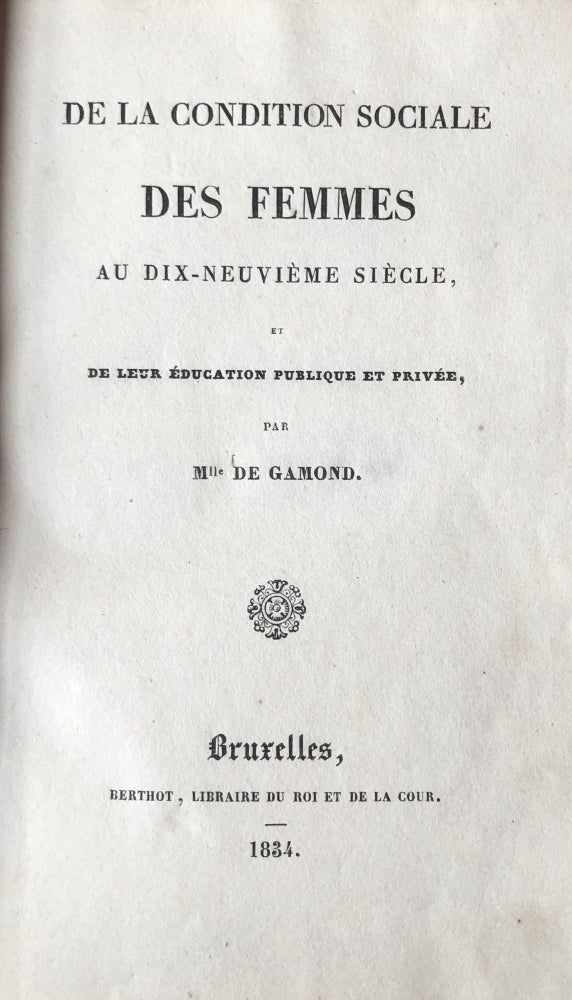De la condition sociale des femmes au dix-neuvième siècle, et de leur éducation publique et privée. Brussels: (H. Rémy for) Berthot, Libraire du Roi et de la Cour, 1834.
18mo (155 x 100 mm). [8], 161, [3] pp. Half-title preserved. Wove paper. Some soiling, a few creases. Contemporary dark violet leather-backed marbled boards, title gilt-lettered on spine (extremities worn). Marginal reader’s marks in first chapter.
First Edition in book form of a foundational text of Belgian feminism. This young woman’s analysis of the social handicapping of women and her call for a radical improvement in women’s education embody the idealism of the time but are unusually precise and well developed. She sets out her arguments in four letters, which had previously appeared serially under the disguised name Marie de G*** in the French Revue Encyclopédique, starting in December 1832. Both the journal issue and this edition, which appears under her full name (Mlle de Gamond; her marriage to Jean-Baptiste Gatti, an Italian refugee painter, took place in 1835), are rare.
De Gamond’s premises, enunciated in the first letter, at first appear neither revolutionary nor fully feminist in the modern sense: far be it from her to dispute conventional wisdom, which ascribed to women the domestic sphere, judging them unfit for the professions reserved for men. De Gamond deplores the constrictions of women’s lives and perspectives, but not because of their assigned role of wives, mothers, and mistresses of households. Rather she sees women as prevented from filling these roles with distinction and from becoming fully morally alive beings because of the poor quality of female education. The heart of her thesis is that women require better education, in two ways: first through what she calls “spontaneous education,” what some now call “self-work,” which she describes in the second letter. She blames women themselves for failing to overcome the egotism and indifference of society, which that could do by treating each other as sisters and transcending social classes in a grand “social pact ... with all of humanity, with women of all conditions and all classes” (p. 51). Arguing that it is lack of education which leaves women powerless over their own lives and hence is the cause of their unhappiness, she insists on the reciprocal effect of education on “les moeurs” (social customs and beliefs), thus leaving open the possibility of radical social change. De Gamond emphasizes that even girls from wealthy families should master either a form of intellectual work or a specialized skill, for moral and psychological reasons, and as a practical means of supporting themselves should they end up without the usual familial resources.
These reflections are developed in the last two chapters, which treat women’s education. Herself an aristocrat, de Gamond was deeply concerned with the education of working class women and of their children. She proposes a well-thought-out system of child care and education for poor families: for the youngest children her proposal sounds like a combination between the modern French crèche and the école maternelle or grammar school. For slightly older girls there would be a “public school” option for the destitute, and for the more well-off, schools with a fee structure; but, other than a slightly different quality of uniforms and food, the education in these elementary schools would be the same. She stresses that her proposed educational system would benefit not only the poor but also women of the upper classes, whom, she claims, she pities more than anyone else for the precarity of their positions (controlled by the men in their lives) and their complete unpreparedness for work. The reader marveling at how progressive this sounds is stopped short as de Gamond moves to her proposals for older girls, as here the schools clearly diverge by class, the poorer students being given only the option of what she calls écoles d’industrie - trade or vocational schools, which would furnish a pool of qualified workers from whom the upper classes could select their servants. To complete the plan and to carry it out, de Gamond proposes a fourth type of school, called (as in modern France) écoles normales, to train young women from poorer sectors of the upper classes to become teachers. In the final letter she defends the notion of institutional education for girls, who were traditionally taught at home, and describes the contents of her proposed educational system in detail.
This book “already contains the ferment that was to be the basis of all Belgian feminism, that is the role of education in improving the condition of women” (Piette, p. 406). Only 26 at the time, de Gamond, the privileged daughter of a prominent and cultivated Brussels family, would go on to make many of her ideas a reality. Her political involvement had commenced with the 1830 revolutions. In 1832 she renounced Saint-Simonianism, after the scandals involving their “guru” Barthélemy-Prosper Enfantin, who preached free love for all but especially for himself, but she maintained numerous links to progressive milieux, later becoming an admirer of the utopian socialist Charles Fourier, and she remained a tireless advocate for the poor and for women’s education. Ignoring the many attacks on her ideas, in 1835 she and her friend Eugénie Poulet founded two schools, one for poor working women, and an école normale. In the 1840s, after a costly attempt to establish a Fourieriste phalanstère in Citeaux, de Gamond and her family suffered financial hardships, but she was eventually granted the post of “Inspectrice générale” of Belgian state girls’ schools. She was the first woman to hold such a position. After her death at the age of 48, her daughter Isabelle Gatti de Gamond continued her efforts, becoming one of the most important Belgian feminists.
OCLC locates 2 copies of this edition, at Williams College and Lyon. Cf. Valérie Piette, “Zoé Gatti de Gamond ou les premières avancées féministes?” and Kaat Wils, “Science, an Ally of Feminism? Isabelle Gatti de Gamond on Women and Science,” both in Revue belge de Philologie et d'Histoire (1999), no. 77-2, pp. 402-415 and 416-439; for an excellent biographical notice, see the entry in Le Maitron: Dictionnaire biographique, Mouvement social, mouvement ouvrier.
No longer available


